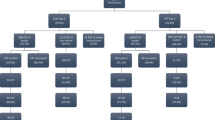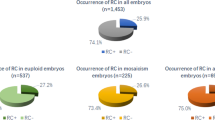Abstract
Purpose
The purpose of the study was to explore the effect of blastomere biopsy for preimplantation genetic diagnosis (PGD) on the embryos’ dynamics, further cleavage, development, and implantation.
Methods
The study group included 366 embryos from all PGD treatments (September 2012 to June 2014) cultured in the EmbryoScope™ time-lapse monitoring system. The control group included all intracytoplasmic sperm injection (ICSI) embryos cultured in EmbryoScope™ until day 5 during the same time period (385 embryos). Time points of key embryonic events were analyzed with an EmbryoViewer™.
Results
Most (88 %) of the embryos were biopsied at ≥8 cells. These results summarize the further dynamic development of the largest cohort of biopsied embryos and demonstrate that blastomere biopsy of cleavage-stage embryos significantly delayed compaction and blastulation compared to the control non-biopsied embryos. This delay in preimplanation developmental events also affected postimplantation development as observed when the dynamics of non-implanted embryos (known implantation data (KID) negative) were compared to those of implanted embryos (KID positive).
Conclusion
Analysis of morphokinetic parameters enabled us to explore how blastomere biopsy interferes with the dynamic sequence of developmental events. Our results show that biopsy delays the compaction and the blastulation of the embryos, leading to a decrease in implantation.




Similar content being viewed by others
References
Gutierrez-Mateo C, Sanchez-Garcia JF, Fischer J, Tormasi S, Cohen J, Munne S, et al. Preimplantation genetic diagnosis of single-gene disorders: experience with more than 200 cycles conducted by a reference laboratory in the United States. Fertil Steril. 2009;92(5):1544–56.
Simpson JL. Preimplantation genetic diagnosis to improve pregnancy outcomes in subfertility. Best Pract Res Clin Obstet Gynaecol. 2012;26(6):805–15.
Adler A, Lee HL, McCulloh DH, Ampeloquio E, Clarke-Williams M, Wertz BH, et al. Blastocyst culture selects for euploid embryos: comparison of blastomere and trophectoderm biopsies. Reprod Biomed Online. 2014;28(4):485–91.
Scott Jr RT, Upham KM, Forman EJ, Zhao T, Treff NR. Cleavage-stage biopsy significantly impairs human embryonic implantation potential while blastocyst biopsy does not: a randomized and paired clinical trial. Fertil Steril. 2013;100(3):624–30.
Scott KL, Hong KH, Scott Jr RT. Selecting the optimal time to perform biopsy for preimplantation genetic testing. Fertil Steril. 2013;100(3):608–14.
Barbash-Hazan S, Frumkin T, Malcov M, Yaron Y, Cohen T, Azem F, et al. Preimplantation aneuploid embryos undergo self-correction in correlation with their developmental potential. Fertil Steril. 2009;92(3):890–6.
Xu K, Montag M. New perspectives on embryo biopsy: not how, but when and why? Semin Reprod Med. 2012;30(4):259–66.
Cimadomo D, Capalbo A, Ubaldi FM, Scarica C, Palagiano A, Canipari R, et al. The impact of biopsy on human embryo developmental potential during preimplantation genetic diagnosis. Biomed Res Int. 2016;2016:7193075.
De Rycke M, Belva F, Goossens V, Moutou C, SenGupta SB, Traeger-Synodinos J, et al. ESHRE PGD Consortium data collection XIII: cycles from January to December 2010 with pregnancy follow-up to October 2011. Hum Reprod (Oxford, England). 2015;30(8):1763–89.
Shapiro BS, Daneshmand ST, Garner FC, Aguirre M, Hudson C. Freeze-all at the blastocyst or bipronuclear stage: a randomized clinical trial. Fertil Steril. 2015;104(5):1138–44.
Mastenbroek S, Twisk M, van der Veen F, Repping S. Preimplantation genetic screening: a systematic review and meta-analysis of RCTs. Hum Reprod Update. 2011;17(4):454–66.
Ajduk A, Zernicka-Goetz M. Quality control of embryo development. Mol Asp Med. 2013;34(5):903–18.
Ugajin T, Terada Y, Hasegawa H, Velayo CL, Nabeshima H, Yaegashi N. Aberrant behavior of mouse embryo development after blastomere biopsy as observed through time-lapse cinematography. Fertil Steril. 2010;93(8):2723–8.
Duncan FE, Stein P, Williams CJ, Schultz RM. The effect of blastomere biopsy on preimplantation mouse embryo development and global gene expression. Fertil Steril. 2009;91(4 Suppl):1462–5.
Tarin JJ, Conaghan J, Winston RM, Handyside AH. Human embryo biopsy on the 2nd day after insemination for preimplantation diagnosis: removal of a quarter of embryo retards cleavage. Fertil Steril. 1992;58(5):970–6.
Chawla M, Fakih M, Shunnar A, Bayram A, Hellani A, Perumal V, et al. Morphokinetic analysis of cleavage stage embryos and its relationship to aneuploidy in a retrospective time-lapse imaging study. J Assist Reprod Genet. 2015;32(1):69–75.
Meseguer M, Herrero J, Tejera A, Hilligsoe KM, Ramsing NB, Remohi J. The use of morphokinetics as a predictor of embryo implantation. Hum Reprod (Oxford, England). 2011;26(10):2658–71.
Rubio I, Galan A, Larreategui Z, Ayerdi F, Bellver J, Herrero J, et al. Clinical validation of embryo culture and selection by morphokinetic analysis: a randomized, controlled trial of the EmbryoScope. Fertil Steril. 2014;102(5):1287–94.e5.
Meseguer M, Rubio I, Cruz M, Basile N, Marcos J, Requena A. Embryo incubation and selection in a time-lapse monitoring system improves pregnancy outcome compared with a standard incubator: a retrospective cohort study. Fertil Steril. 2012;98(6):1481–9.e10.
Herrero J, Tejera A, Albert C, Vidal C, de los Santos MJ, Meseguer M. A time to look back: analysis of morphokinetic characteristics of human embryo development. Fertil Steril. 2013;100(6):1602–9.e1-4.
Chamayou S, Patrizio P, Storaci G, Tomaselli V, Alecci C, Ragolia C, et al. The use of morphokinetic parameters to select all embryos with full capacity to implant. J Assist Reprod Genet. 2013;30(5):703–10.
Herrero J, Meseguer M. Selection of high potential embryos using time-lapse imaging: the era of morphokinetics. Fertil Steril. 2013;99(4):1030–4.
Wu L, Han W, Zhang X, Wang J, Liu W, Xiong S, et al. A retrospective analysis of morphokinetic parameters according to the implantation outcome of IVF treatment. Eur J Obstet Gynecol Reprod Biol. 2016;197:186–90.
Park H, Bergh C, Selleskog U, Thurin-Kjellberg A, Lundin K. No benefit of culturing embryos in a closed system compared with a conventional incubator in terms of number of good quality embryos: results from an RCT. Hum Reprod (Oxford, England). 2015;30(2):268–75.
Mizobe Y, Oya N, Iwakiri R, Yoshida N, Sato Y, Miyoshi K et al. Effects of early cleavage patterns of human embryos on subsequent in vitro development and implantation. Fertil Steril. 2016.
Yang Z, Zhang J, Salem SA, Liu X, Kuang Y, Salem RD, et al. Selection of competent blastocysts for transfer by combining time-lapse monitoring and array CGH testing for patients undergoing preimplantation genetic screening: a prospective study with sibling oocytes. BMC Med Genet. 2014;7:38.
Rienzi L, Capalbo A, Stoppa M, Romano S, Maggiulli R, Albricci L, et al. No evidence of association between blastocyst aneuploidy and morphokinetic assessment in a selected population of poor-prognosis patients: a longitudinal cohort study. Reprod Biomed Online. 2015;30(1):57–66.
Kaser DJ, Racowsky C. Clinical outcomes following selection of human preimplantation embryos with time-lapse monitoring: a systematic review. Hum Reprod Update. 2014;20(5):617–31.
Armstrong S, Arroll N, Cree LM, Jordan V, Farquhar C. Time-lapse systems for embryo incubation and assessment in assisted reproduction. Cochrane Database Syst Rev. 2015;2:Cd011320.
Kirkegaard K, Hindkjaer JJ, Ingerslev HJ. Human embryonic development after blastomere removal: a time-lapse analysis. Human Reprod (Oxford, England). 2012;27(1):97–105.
Cruz M, Garrido N, Herrero J, Perez-Cano I, Munoz M, Meseguer M. Timing of cell division in human cleavage-stage embryos is linked with blastocyst formation and quality. Reprod Biomed Online. 2012;25(4):371–81.
Staessen C, Verpoest W, Donoso P, Haentjens P, Van der Elst J, Liebaers I, et al. Preimplantation genetic screening does not improve delivery rate in women under the age of 36 following single-embryo transfer. Hum Reprod (Oxford, England). 2008;23(12):2818–25.
Debrock S, Melotte C, Spiessens C, Peeraer K, Vanneste E, Meeuwis L, et al. Preimplantation genetic screening for aneuploidy of embryos after in vitro fertilization in women aged at least 35 years: a prospective randomized trial. Fertil Steril. 2010;93(2):364–73.
Hardarson T, Hanson C, Lundin K, Hillensjo T, Nilsson L, Stevic J, et al. Preimplantation genetic screening in women of advanced maternal age caused a decrease in clinical pregnancy rate: a randomized controlled trial. Hum Reprod (Oxford, England). 2008;23(12):2806–12.
Pratt HP, Ziomek CA, Reeve WJ, Johnson MH. Compaction of the mouse embryo: an analysis of its components. J Embryol Exp Morphol. 1982;70:113–32.
Clayton L, Stinchcombe SV, Johnson MH. Cell surface localisation and stability of uvomorulin during early mouse development. Zygote (Cambridge, England). 1993;1(4):333–44.
Sefton M, Johnson MH, Clayton L, McConnell JM. Experimental manipulations of compaction and their effects on the phosphorylation of uvomorulin. Mol Reprod Dev. 1996;44(1):77–87.
Pey R, Vial C, Schatten G, Hafner M. Increase of intracellular Ca2+ and relocation of E-cadherin during experimental decompaction of mouse embryos. Proc Natl Acad Sci U S A. 1998;95(22):12977–82.
Rink K, Delacretaz G, Salathe RP, Senn A, Nocera D, Germond M, et al. Non-contact microdrilling of mouse zona pellucida with an objective-delivered 1.48-microns diode laser. Lasers Surg Med. 1996;18(1):52–62.
Taylor TH, Gilchrist JW, Hallowell SV, Hanshew KK, Orris JJ, Glassner MJ, et al. The effects of different laser pulse lengths on the embryo biopsy procedure and embryo development to the blastocyst stage. J Assist Reprod Genet. 2010;27(11):663–7.
Malter HE, Cohen J. Blastocyst formation and hatching in vitro following zona drilling of mouse and human embryos. Gamete Res. 1989;24(1):67–80.
Cohen J, Feldberg D. Effects of the size and number of zona pellucida openings on hatching and trophoblast outgrowth in the mouse embryo. Mol Reprod Dev. 1991;30(1):70–8.
Schmoll F, Schneider H, Montag M, Wimmers K, Rink K, Schellander K. Effects of different laser-drilled openings in the zona pellucida on hatching of in vitro-produced cattle blastocysts. Fertil Steril. 2003;80 Suppl 2:714–9.
Dahdouh EM, Balayla J, Audibert F, Wilson RD, Audibert F, Brock JA, et al. Technical update: preimplantation genetic diagnosis and screening. J Obstet Gynaecol Canada. 2015;37(5):451–63.
Kokkali G, Traeger-Synodinos J, Vrettou C, Stavrou D, Jones GM, Cram DS, et al. Blastocyst biopsy versus cleavage stage biopsy and blastocyst transfer for preimplantation genetic diagnosis of beta-thalassaemia: a pilot study. Hum Reprod (Oxford, England). 2007;22(5):1443–9.
Gross L. Built-in timer delays differentiation. PLoS Biol. 2012;10(1):e1001254.
Acknowledgments
Embryologists Ariela Carmon, Shiri Asaf, Roni Rahav, and Alina Shpitz are thanked for embryo assessment and documentation. Dana Hadar Fruchter, statistical advisor, is thanked for statistical analysis; Sharon Cooper, statistical advisor, is thanked for descriptive statistics, Esther Eshkol for editorial assistance.
Author information
Authors and Affiliations
Corresponding author
Additional information
Capsule Morphokinetic analysis demonstrated that blastomere biopsy interferes with the dynamic sequence of developmental events, delaying compaction and blastulation of the embryos and leading to a decrease in implantation rate.
This work was performed in partial fulfillment of the M.D. thesis requirements of the Sackler Faculty of Medicine, Tel Aviv University.
Electronic supplementary material
Below is the link to the electronic supplementary material.
Supplemental Table 1
(DOCX 13 kb)
Supplemental Table 2
(DOCX 13 kb)
Supplemental Table 3
(DOCX 13 kb)
Rights and permissions
About this article
Cite this article
Bar-El, L., Kalma, Y., Malcov, M. et al. Blastomere biopsy for PGD delays embryo compaction and blastulation: a time-lapse microscopic analysis. J Assist Reprod Genet 33, 1449–1457 (2016). https://doi.org/10.1007/s10815-016-0813-2
Received:
Accepted:
Published:
Issue Date:
DOI: https://doi.org/10.1007/s10815-016-0813-2




